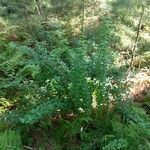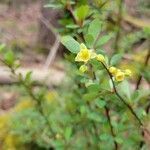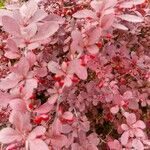Deciduous shrub to 4 m high, often dense, multistemmed. Spines simple (occasionally 3-fid), 5–18 mm long. Leaves spathulate to elliptic or obovate (sometimes appearing rhombic-or diamond-shaped),10–35 (–45) mm long, 5–15 (–22) mm wide, thin, glabrous, venation ±obscure, upper surface green or yellow-green, dull, lower surface paler or greyish, base tapering, margin entire, apex rounded or obtuse; petiole indistinct due to tapering lamina, to c. 8 mm long. Flowers (1–) 2–5 (rarely to 12) in umbels or subumbellate racemes, yellow stained red, to c. 10 mm across. Berries ellipsoid, to 8 mm long, to 4.5 mm wide, maturing red or orange-red, shiny, without a bloom, style absent, ovules 1 or 2.
Shrubs , deciduous, 0.3-3 m. Stems dimorphic, with short axillary shoots. Bark of 2d-year stems purple or brown, glabrous. Bud scales 1-2 mm, deciduous. Spines present, simple or 3-fid. Leaves simple; petioles 0-0.8 cm. Leaf blade obovate to spatulate, 1-veined from base, (0.5-)1.2-2.4 × 0.3-1(-1.8) cm, thin and flexible, base long-attenuate, margins plane, entire, apex rounded or obtuse; surfaces abaxially dull, smooth, adaxially dull, scarcely glaucous. Inflorescences umbellate, 1-5-flowered, 1-1.5 cm; bracteoles membranous, apex acute. Flowers: anther filaments without distal pair of recurved lateral teeth. Berries red, ellipsoid or spheric, (7-)9-10 mm, juicy, solid.
A shrub. It grows 1.2-1.8 m tall. It is spiny and loses its leaves during the year. It spreads 1.8-2.5 m wide. The leaves are small and neatly rounded. The leaves turn bright red or orange in autumn. The flowers are straw coloured with dull red stripes. They are small and bell shaped. The fruit are small oval berries which turn scarlet. Several named varieties occur.
Densely and divaricately branched, to 2 m; spines usually simple; lvs obovate to spatulate, mostly obtuse, entire, short-petiolate; fls solitary or in umbel-like clusters of 2–4, 8 mm wide; fr 1 cm; 2n=28. Native of Japan, frequently escaped from cult. along roadsides and in thickets in our range. May.












